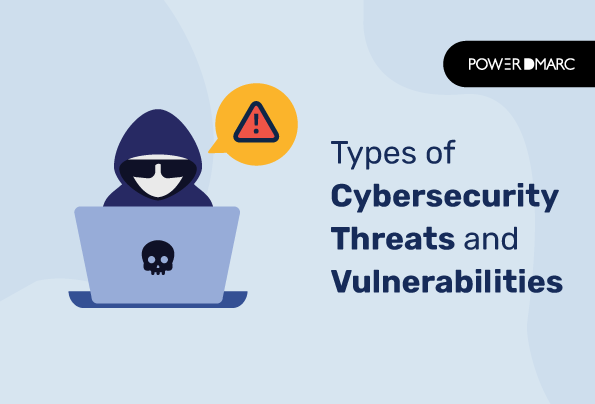At present, cybersecurity threats and vulnerabilities are everywhere, and organizations have to steer them to remain competitive. Fortunately, we now have powerful AI-driven tools gaining popularity just like AI-powered language models. While language models respond instantly to simple prompts like “How to prevent email phishing?” or “Write an essay for me,”, AI-driven cybersecurity solutions play an active role in attack detection, mitigation, and incident response. However, AI isn’t perfect. While some of the information is often accurate, it still has some drawbacks and may spread misinformation. To discover important vulnerabilities, our guide can be a good starting point.
Common Cybersecurity Threats
1. Malware Attacks
Malicious software involves actions made to infiltrate and damage computers and their systems. Malware can come in many different forms. Viruses and Trojans are two such forms. .
Viruses: When launched, a computer virus can infiltrate different programs and self-replicate. It, in turn, slows down systems and attempts to spread to new devices using infected files.
Trojans: These targeted threats often masquerade as legitimate software but contain hidden malicious code. It’s intended for cybercrimes looking for unwarranted entry points into systems.
Ransomware: When ransomware infiltrates files or systems, it asks for payment in exchange for decrypting them. High-profile cases like WannaCry and NotPetya caused large disruption.
Spyware: Spyware collects information from user devices without their knowledge. This information includes passwords and other personal details, which attackers may steal and sell.
2. Phishing and Social Engineering
Phishing attacks use manipulative tricks. Why? To talk individuals into providing sensitive data or taking some harmful steps. Social engineering often plays a part in the following:
Phishing Emails: Attackers send fake emails to talk recipients into clicking malicious links. Their goal is to convince recipients to launch downloads or reveal personal data. These emails can refer to sales, deals, or fake alerts about personal information.
Social Engineering Scams: Scammers exploit victims by preying upon human psychology, trust, and emotions. They’re using methods like impersonation, pretexting, baiting, and tailgating. The goal is to extract money from them.
3. Distributed Denial of Service (DDoS) Attacks
DDoS (Distributed Denial-of-Service) attacks target online services, websites, or networks. They do so by sending an overwhelming volume of traffic their way.
Targets include websites, networks, and servers accessible via HTTP connections. These come under attack from botnets, IoT devices, or compromised computers. Attackers use these computers for DDoS attacks against high-profile targets. During 2023, there was a 47% surge in attacks when compared to the previous year.
Emerging Cybersecurity Threats
1. IoT Vulnerabilities
The Internet of Things (IoT) connects everyday sensory or software devices to other devices over the web for ease. It also poses potential security and privacy threats:
Security issues: Internet of Things devices often lack strong security features. Their missing firmware updates can’t prevent cybercriminals from harming them. Security issues can arise in smart home devices. These include cameras and medical devices, collecting data for malicious gain.
Privacy concerns: IoT data collection devices could collect sensitive personal information, compromising individuals’ privacy. Any unauthorized access can be a threat to an individual’s well-being.
2. Artificial Intelligence and Machine Learning Threats
AI and machine learning (ML) promises great potential in cyber defense. With that, attackers can misuse their power:
AI-Driven Attacks: Cybercriminals use AI algorithms to make attacks harder to detect. They are increasing sophistication levels through deepfakes that may worsen social engineering risks.
AI-Powered Defense: Security experts rely on AI/ML tools to detect threats and respond to them. They use adaptive mechanisms that learn from and adapt to new attacks.
3. Supply Chain Attacks
Supply chain attacks take advantage of the organization’s suppliers, contractors, or partners:
Compromised Software Updates: Attackers can enter an organization’s software supply chain and distribute malicious updates. These infiltrate unwitting users’ computers, leading to further chaos and damage.
Third-Party Risks: Organizations may face cyber risks from third-party suppliers and vendors. These could result in data breaches or financial losses. These pose great damage to an organization’s reputation.
Types of Cybersecurity Vulnerabilities
Cybersecurity vulnerabilities come in various forms, posing distinct threats to organizational data and systems. There are two primary categories: technical vulnerabilities affecting software and systems, and human-related vulnerabilities stemming from user behavior.
Cyber attackers use vulnerabilities as entryways. They create opportunities to launch successful cyber attacks against you.
1. Software and System Vulnerabilities
Patching: To mitigate cyber threats as soon as they appear, repair any flaws as soon as they arise. Regular software updates and security patches provide much-needed defenses. Failing to take this measure leaves them open to attack.
Zero-Day Vulnerabilities: Zero-day exploits are unknown vulnerabilities that attackers exploit to enter. Security researchers and software vendors can work together to identify these issues as they arise.
2. Human Error and Insider Threats
Human error and insider threats pose major cybersecurity threats:
Phishing and Social Engineering: Employees may become victims of phishing attacks and social engineering scams. Training and awareness programs can help lower the chances of a risk.
Insider Threats: Insider threats come from employees and contractors within any organization. They attract them by remaining exposed for too long, endangering company operations. Insider attacks could involve data breaches. Extreme cases include intentional acts to harm company operations. The results are data theft or even potential financial loss for the company.
These human-related vulnerabilities can be mitigated by solutions like VPN for Windows, which encrypts Internet traffic and protects data, especially for remote workers and public Wi-Fi users.
Final Words
Ever-evolving threats and vulnerabilities fill the digital landscape. This means organizations should remain alert at all times to remain secure online. Staying informed and investing in safety measures are of utmost importance.
By understanding different cybersecurity threats we can keep our digital assets safe, as being proactive is the only way forward.
- Can Blockchain Help Improve Email Security? - May 9, 2024
- Datacenter Proxies: Unveiling the Workhorse of the Proxy World - May 7, 2024
- Kimsuky Exploits DMARC “None” Policies in Recent Phishing Attacks - May 6, 2024
